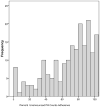Stress and poverty predictors of treatment adherence among people with low-literacy living with HIV/AIDS
- PMID: 20716711
- PMCID: PMC3016469
- DOI: 10.1097/PSY.0b013e3181f01be3
Stress and poverty predictors of treatment adherence among people with low-literacy living with HIV/AIDS
Abstract
Objective: To examine the association of social, health, and poverty-related stressors in relation to antiretroviral therapy adherence in a sample of people with low-literacy living with HIV/AIDS in the southeastern United States. Emotional distress is among the more common factors associated with HIV treatment adherence. Typical barriers to adherence may be overshadowed by poverty experiences in the most disadvantaged populations of people living with HIV/AIDS, such as people with lower-literacy skills.
Methods: One hundred eighty-eight men and women living with HIV/AIDS who demonstrated poor health literacy completed measures of social and health-related stress, indicators of extreme poverty, as well as other factors associated with nonadherence. HIV treatment adherence was monitored prospectively, using unannounced pill counts.
Results: Two-thirds of the sample demonstrated adherence <85% of pills taken. Multivariable analyses showed that food insufficiency and hunger predicted antiretroviral therapy nonadherence over and above depression, internalized stigma, substance use, and HIV-related social stressors.
Conclusions: Interventions for HIV treatment nonadherence with the most socially disadvantaged persons in developed countries should be reconceptualized to directly address poverty, especially food insufficiency and hunger, as both a moral and public health imperative.
Figures
References
-
- Bangsberg DR, Kroetz DL, Deeks SG. Adherence-resistance relationships to combination HIV antiretroviral therapy. Curr HIV/AIDS Rep. 2007 May;4(2):65–72. - PubMed
Publication types
MeSH terms
Substances
Grants and funding
LinkOut - more resources
Full Text Sources
Other Literature Sources
Medical


